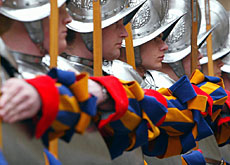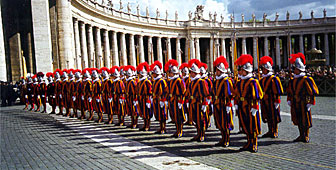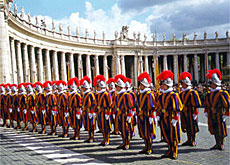Catching the Pope’s soldiers off their guard

The colourful Swiss Guards standing motionless at the gates are as much a part of the Vatican as the awe-inspiring dome of St Peter’s.
swissinfo caught a rare glimpse into the life of a guard with the world’s smallest army.
Twenty-one-year-old Stefan Busslinger is not what you would expect of a soldier in the exclusive army, which is made up of 100 Swiss Catholic men.
Slightly-built and dressed in jeans and T-shirt rather than in the customary Renaissance garb, Busslinger met me at the porter’s lodge of the Guards’ quarters which are tucked away to one side of the Vatican.
Two cobbled courtyards – flanked by a giant Swiss flag and a sculpture of heroic guards – lead to a set of old buildings housing the army offices and barracks – where even married guards must live with their families.
There is also a tiny, renovated chapel, on this occasion brimming with half a dozen praying Polish nuns.
“They’re our cooks,” whispers Busslinger. “The Swiss nuns we used to have were less frightening!”
Too many rules
Busslinger joined the contingent 18 months ago, after doing his military service and working in marketing. Like all recruits, he is single and a practising Roman Catholic who is clearly proud to serve the Pope.
Yet he admits he is unlikely to remain in Vatican City beyond his minimum two-year term.
“I used to see the Swiss Guards on television as a kid and I was very impressed. But I was a bit disappointed when I realised that things weren’t how I’d imagined,” he admits.
“It’s a very particular kind of life we lead,” he continues. “It’s very regimented and there are too many rules.”
Guards have to work alternate days and nights guarding the Apostolic Palace, the papal apartment and the four main entrances of the Vatican.
Deeply religious
They are also in charge of the pontiff’s palace when he travels outside the Holy See and they must always be on standby to work on their days off should the Pontiff decide to hold a special mass.
“It’s frustrating because you’re never really free,” Busslinger explains.
“Some of the guards are deeply religious and rarely leave the Vatican but I like to get out and socialise with normal Romans and it’s difficult to plan. And if you have a girlfriend, you can’t see her very much!”
As part of their training, guards learn judo and the use of firearms – though they seldom carry them as the Pope “as a man of peace is against the use of weapons”, Busslinger says.
One of the toughest aspects of the job for any new recruit, he says, is learning to stand immobile for at least two hours at a time.
“All new recruits are broken in with the service of honour, which is physically quite demanding.
“It’s particularly tough if you stand in the summer heat in St Peter’s Square with 30,000 people watching you, when you can feel the sweat running down your back.”
Vatican insiders
Recruits are also rigorously tested on the intricate workings of the Vatican and on the people who run it.
“You can’t bar the path of a cardinal, so it’s important to know who everyone is and treat them accordingly,” he explains.
The awe Busslinger says he felt during his first weeks at the Vatican has worn off to be replaced by a more realistic view of Vatican staff.
“When I first arrived I thought everyone working here would be somehow unreal or godlike,” he recalls. “But they are humans with human flaws.”
He also hints that he is sometimes shocked “at the way things are done here” but is evasive when pressed to give examples.
Busslinger is similarly guarded on the question of the mysterious murder in 1998 of the head of the Swiss Guard, Alois Estermann, and his wife.
Lawyers representing the family of the accused, Cédric Tornay, published a book disputing the Vatican’s version of events, according to which a member of the Swiss Guard shot the pair before turning the gun on himself.
“Sometimes we’ll speculate among ourselves about what might have happened but it’s not a subject that’s talked about here.”
swissinfo, Vanessa Mock
The Swiss Guard consists of 100 Roman Catholic men, who serve for two to 25 years.
They are trained in self-defence, shooting, Italian and must study the organisational structure of the Vatican.
New recruits take an oath promising fidelity to the Pope and the Church and have a personal audience with the Pontiff.
The Swiss Guard was founded in 1506 by Pope Julius II as a stable and disciplined corps of regular Swiss soldiers.
Many died while defending the Holy See during the Sack of Rome in 1527.
The Pope plans to meet several former Swiss Guards during his visit to Switzerland on June 5-6.

In compliance with the JTI standards
More: SWI swissinfo.ch certified by the Journalism Trust Initiative


You can find an overview of ongoing debates with our journalists here. Please join us!
If you want to start a conversation about a topic raised in this article or want to report factual errors, email us at english@swissinfo.ch.